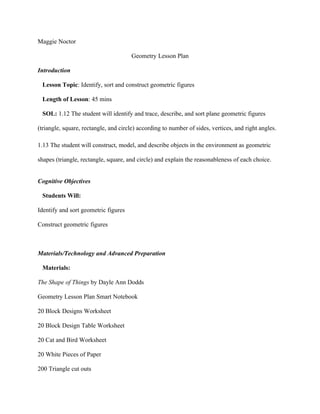
Geometry lesson plan with Smart Board
- 1. Maggie Noctor Geometry Lesson Plan Introduction Lesson Topic: Identify, sort and construct geometric figures Length of Lesson: 45 mins SOL: 1.12 The student will identify and trace, describe, and sort plane geometric figures (triangle, square, rectangle, and circle) according to number of sides, vertices, and right angles. 1.13 The student will construct, model, and describe objects in the environment as geometric shapes (triangle, rectangle, square, and circle) and explain the reasonableness of each choice. Cognitive Objectives Students Will: Identify and sort geometric figures Construct geometric figures Materials/Technology and Advanced Preparation Materials: The Shape of Things by Dayle Ann Dodds Geometry Lesson Plan Smart Notebook 20 Block Designs Worksheet 20 Block Design Table Worksheet 20 Cat and Bird Worksheet 20 White Pieces of Paper 200 Triangle cut outs
- 2. 200 Square cut outs 200 Circle cut outs 200 Rectangle cut outs 200 Hexagon cut outs 20 Plastic bags Advanced Preparation: 1. Prepare bags of items for students 2. Cut out 10 of each triangle for each student 3. Cut out 10 of each shape for each student 4. Put in 10 of each shape into a bag for each student 5. Pass out the bags to student desks. Teaching and Learning Sequence Introduction/Anticipatory Set: • Take out The Shape of Things book from the front desk • Read The Shape of Things by Dayle Ann Dodds • Open up the Smart Board Lesson Plan. • Go through the Smart Board Lesson with students, having volunteers come to the board to manipulate the lesson and answer the questions. Lesson Development: • Distribute bags of shapes to each table, each student. • Pass out one sheet of paper per student • Tell students that today we will be talking about different shapes.
- 3. • Then tell students to take the objects from their bag and look at the different shapes they have. • Give the students a minute to look at, play with and feel the shapes. • Once the students have looked at the different shapes in their hands, hand out the flower block worksheet. • Tell the students that they should use their shapes to cover up the flower. • Then they should mark down on the block table worksheet what shapes they used and how many of each shape they used. • When they are done, have them discuss with their table about what number of shapes they used. • Ask the whole class how many shapes they used for each shape, write the class totals on the board. • Then show the class one or two examples of animals made only out of shapes. • Tell the students that they will now use the shapes they have to glue to a white piece of paper to make animals of their choice. • If needed students may use the cat or bird pictures attached. Closure: • When students are completed making their pictures have a couple of students show the class what they made. • Make sure the students name the shapes they used as they explain their pictures. • Collect students animal shape creations. • Talk about how all objects around us are made out of different shapes kind of like the objects in the book we read today.
- 4. • Explain to students that their homework is to go home and find two objects that are made different shapes, to list the object and the different shapes that make up that object. Homework: Find two objects that are made of different shapes, list the object and the different shapes that make up the object. Assessment: Formative: • Listen to answers given during the review of numbers used in the book The Shape of Things. Are the students naming shapes from the book or can they not recall any? • Watch while students are using the shapes to create the flower and sun; do they look confused or wait to choose their shapes after a classmate has helped? Or are they using the right shapes and writing them down correctly? Summative: • Have students at end of the lesson name the shapes of animals that they made, watch for students who still look confused. • Collect the papers with the students’ animal shapes; do they have the shapes named correctly? Are they only calling equilateral triangles, triangles or do they understand that different objects make up other shapes? References: Block Designs. (1998). Houghton Mifflin Company. http://www.proteacher.com/redirect.php? goto=981.
- 5. Geometry Animals. (2010). Lorena Hernandez. http://www.lessonplanspage.com/MathScienceArtLAMDGeometryAnimalsK1.htm. Smart Exchange Standards. (2011). Smart Technologies ULC. http://exchange.smarttech.com/curriculum-list.html? state=Virginia+Standards+of+Learning&stateName=Virginia+Standards+of+Learning&grade= Grade+1&subject=Mathematics.